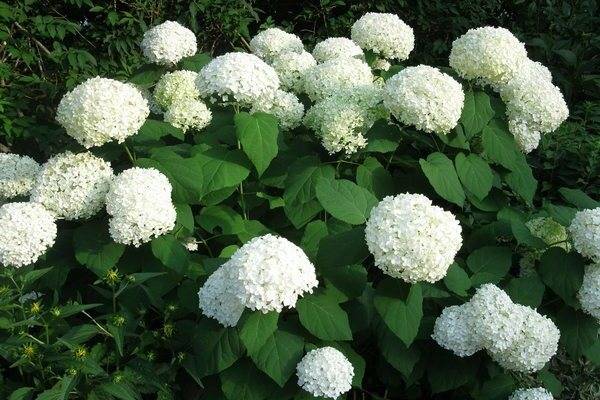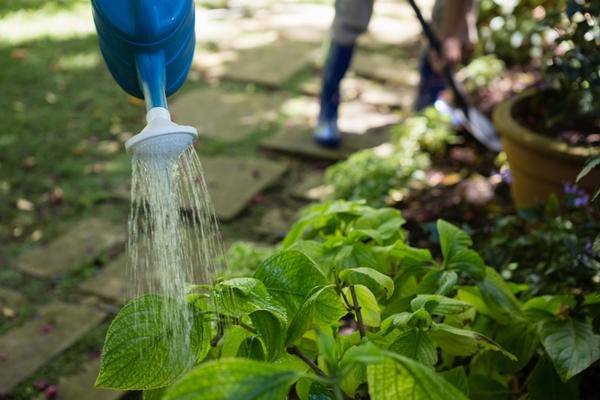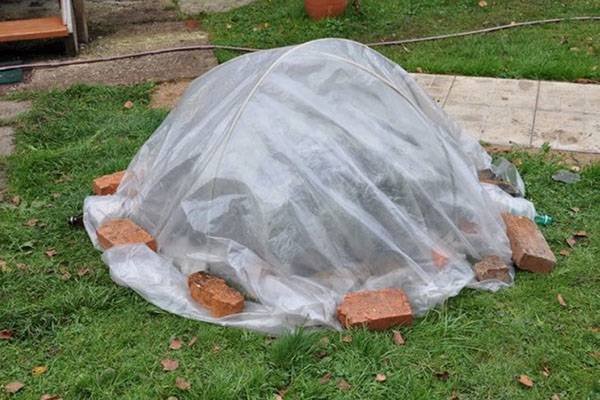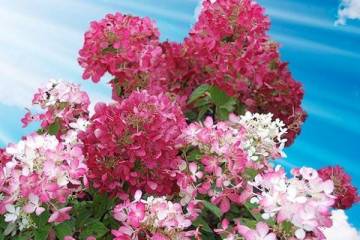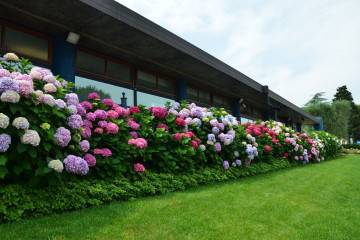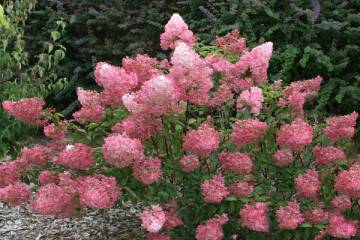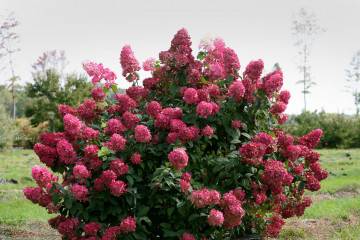Hydrangea in Siberia - planting and care in the open field
Content:
If you like hydrangea, in Siberia planting and caring in the open air will require a lot of effort, but the lost time will pay off with a picturesque garden created with the help of this thermophilic plant. Subject to the rules specified in the description, the shrub will delight its owner all summer long.
Hydrangea in Siberia: planting and care
Most growers use hydrangea as an ornamental home flower, but some manage to decorate their backyard with it. The cold climate does not allow leaving shrubs without shelter, otherwise they can become seriously ill and die.
The origin and appearance of hydrangea
There are two versions of the name of hydrangea:
- the first is associated with F. Commerson, who in the 18th century. first saw her in Japan and named her after his beloved woman;
- the second is associated with the name of Princess Hortense, after whom one of the members of the round-the-world expedition named the shrub and brought a flower from about. Mauritius.
The culture came from Japan to Europe in 1820, and from 1900 botanists began to use it to obtain new varieties. The first attempts ended with the breeding of indoor flowers that were not able to live in personal plots.
The garden type of culture is a perennial shrub that grows up to 2 m. Inflorescences that appear in May-September are up to 30 cm in diameter. Each bush has about a hundred pieces.
Flower descriptions
The inflorescence has a spherical shape, it consists of two types of flowers:
- fertile are located in the center, are small in size;
- sterile larger volumes are localized at the edges.
Most hydrangea subspecies have white petals, but there are hybrids with cream, blue, red, lilac, pinkish shades. After wilting, seed pods are formed, consisting of 2-5 chambers, filled with small seeds.
Types and varieties of hydrangea
Despite the variety of hydrangea subspecies, not all are suitable for growing in the harsh Siberian conditions. Preference is given to two varietal varieties - paniculate and tree-like.
Tree hydrangea
Treelike hydrangea in Siberia is grown more often due to the fact that it adapts well to the terrain and resists many diseases.
The main subspecies grown in Siberia:
- Annabelle. It grows up to 1.5 m, the width of the bush is 3.5 m. Large snow-white inflorescences adorn the site from late June to October. The culture easily tolerates frost down to −28 ° C; in case of great cold weather, it requires transplanting into a pot and wintering indoors;
- Invincibelle Spirit. It transfers cold to -38 ° C. The buds are initially pink, then turn crimson. Blooms in June-September. Shrub height 1.3 m, diameter 1.5 m;
- Strong Annabelle with domed inflorescences, initially snow-white, and at the end of the season greenish. It grows up to 1.5 m in height and 1.3 m in width. The foliage is preserved until frost. The variety tolerates temperatures down to -34 ° C.
In addition to these options, there is another type of hydrangea - large-leaved. Its inflorescences outwardly resemble a wide wheel, the buds form from the last week of August to November. A significant disadvantage is its low frost resistance (up to −25 ° C), requiring the transfer of the shrub to a warm place for the entire dormant period.
Paniculata
The best panicle hydrangea in Siberia is:
- Hydrangea Silver Dollar. It grows up to 2 m. The flowers are of a snow-white shade, collected in cone-shaped inflorescences. At the end, the petals turn pinkish undertones. The variety easily tolerates a cold snap down to -25 ° С;
- Medical Fire is distinguished by a gradual change in the color of the petals during the growing season: snow-white, pink, red;
- Limelight grows up to 1.8 m, belongs to compact shrubs with lemon inflorescences. It tolerates frosts down to -30 ° С.
Transplant after purchase in open ground in Siberia
It is better to buy and transplant a crop in the spring, the specific dates depend on the temperature indicators of the region. Planting hydrangeas in spring in open ground in Siberia takes place from the last week of April to the first week of May.
What is needed for landing
The culture requires a soil consisting of 2 parts of peat and 1 part of river sand and humus. Needles are added to increase the acidity. Planting holes are located at a distance of 60 cm, for small specimens - 50 × 50 cm, for large ones - 80 × 80 cm.
When to plant hydrangea outdoors in spring in Siberia? Only after the end of the frost.
Choosing the best place
The shrub needs to be planted:
- in a wind-protected area;
- near a fence or solid hedge;
- in partial shade.
The step-by-step process of planting hydrangeas
The instructions specify the following algorithm:
- For 2-3 hours, the planting holes are watered abundantly.
- The bottom of the hole is covered with a soil-peat mixture.
- The seedling is placed in the center.
- After spreading the roots, they are evenly covered with a mixture of sour peat and fertile soil.
- The root collar is deepened by 4 cm.
- The soil is compacted.
Reproduction of hydrangea
Planting, breeding and caring for hydrangeas in Siberia is carried out according to the standard scheme. New bushes are obtained by seed method and cuttings.
Propagation by cuttings
Pruning is obtained from adult shoots of the previous season. In the summer, take green cuttings, which are rooted in open ground, covered with a film, or in a greenhouse. The first buds will form in 24 months.
Growing from seeds
Seed material is planted in containers filled with:
- river sand;
- peat;
- leafy and soddy soil;
- humus.
The container is filled completely, leaving 3-4 cm on top. Not germinated seeds are scattered over the substrate, the germinated ones must be deepened by 1 cm. After spraying, the containers are covered with glass or polyethylene, and regularly opened for ventilation and irrigation. The shelter is removed when the first shoots appear.
Some types of hydrangeas do not have time to grow in a short summer and can only reproduce by cuttings or cuttings.
Care in the Siberian climate
The care includes standard procedures: soil moistening, loosening, crusting and pre-winter preparation.
Watering mode
Irrigation is carried out as the soil dries out. For the procedure, you need soft, previously settled water.
Top dressing
Fertilized four times per season:
- in the spring with manure or nitroammophos;
- in June nitroammophos;
- when forming buds with potassium-phosphorus solutions;
- in late autumn, 5 kg of rotted compost is laid out under each shrub.
Features of care during flowering
During the active development of the buds, the earth should not be allowed to dry out, it is necessary to apply top dressing in a timely manner and prevent attacks of parasitic insects and the development of diseases. When they appear, the shrubs are treated with insecticidal solutions, and the affected shoots are removed.
Features of care during the rest period
With the onset of the first warm days, a cardinal pruning is carried out, which will allow you to give the bushes the desired shape. The procedure should be carried out annually. After winter, all dried parts are removed.
In cold areas, pruning is not carried out during the fall months.
Preparing for the Siberian winter
Preparatory work requires the following requirements:
- the root system is earthed to a height of 0.3 m, the main layer is compost or peat;
- when laying shoots on the ground, boards, cardboard or spruce branches are placed under them, carefully fixed;
- moisture should not get under the covering material;
- frost resistance depends on the age of the culture: the older, the better it tolerates cold.
With proper care of hydrangea, it grows quietly in areas with a harsh Russian climate, especially in the western part of Siberia. Compliance with the requirements will allow you to enjoy blooming flower beds annually, to avoid the death of shrubs. It is not difficult to take care of a heat-loving beauty, regular watering, top dressing and spring pruning will allow you to grow healthy and lush bushes.
